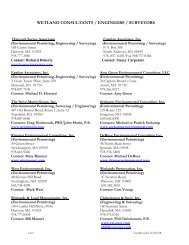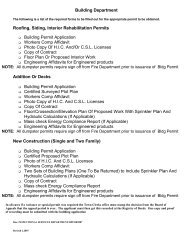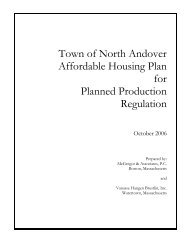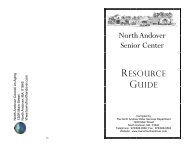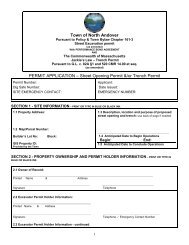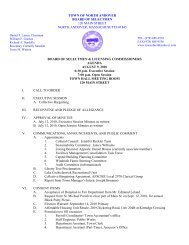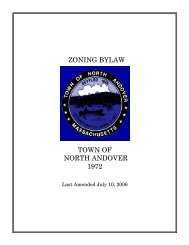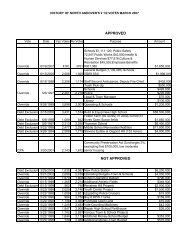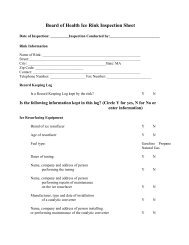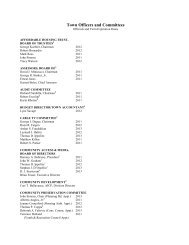Open Space and Recreation Plan - Town of North Andover
Open Space and Recreation Plan - Town of North Andover
Open Space and Recreation Plan - Town of North Andover
You also want an ePaper? Increase the reach of your titles
YUMPU automatically turns print PDFs into web optimized ePapers that Google loves.
T O W N O F N O R T H A N D O V E R<br />
O P E N S P A C E A N D R E C R E A T I O N P L A N 2 0 0 6<br />
2 0 1 0 U P D A T E<br />
Prehistoric Resources<br />
Prior to European settlement, inl<strong>and</strong> sites such as <strong>North</strong> <strong>Andover</strong> were used as seasonal hunting grounds in the<br />
spring <strong>and</strong> fall <strong>and</strong> perhaps to till small gardens. Although no large-scale or town-wide archaeological survey<br />
has been undertaken, certain inferences can be made from the available data. The Massachusetts Historical<br />
Commission reports that a few archaeological sites have been unearthed along the present shoreline <strong>of</strong> Lake<br />
Cochichewick. (Other sites likely exist on the original shoreline, which has since been flooded.) According to<br />
information compiled by Ripley Bulen in “Excavations in <strong>North</strong>eastern Massachusetts” (1949), over one<br />
hundred prehistoric sites have been discovered in the Shawsheen <strong>and</strong> upper Ipswich River drainages. All <strong>of</strong><br />
these sites are along streams or ponds. Native people frequented water bodies since many <strong>of</strong> the fish, plants <strong>and</strong><br />
animals they sought could be found there. Rivers also provided transportation routes.<br />
Considering the high percentage <strong>of</strong> prehistoric sites along water bodies, a site's archaeological potential should<br />
be investigated when any waterfront site is considered for acquisition. Prehistoric sites are prone to<br />
disturbance, v<strong>and</strong>alism <strong>and</strong> illegal excavation. Due to the sensitive nature <strong>of</strong> these sites, if any are discovered<br />
the exact location should not be made public.<br />
Historic Resources<br />
<strong>North</strong> <strong>Andover</strong> includes a number <strong>of</strong> well preserved buildings <strong>and</strong> l<strong>and</strong>scapes from the date <strong>of</strong> original<br />
settlement in the 17 th Century through the 20 th Century. The Historic Commission has identified over 400<br />
structures <strong>of</strong> historic interest (see also Stephen Roper, A Good In-L<strong>and</strong> <strong>Town</strong>: Buildings <strong>and</strong> l<strong>and</strong>scapes in<br />
<strong>North</strong> <strong>Andover</strong>, Massachusetts, from 1640 to 1940, published by the <strong>North</strong> <strong>Andover</strong> Historical Society in<br />
2001). There are three (3) National Register Districts in town; the Old Center, with a surprising number <strong>of</strong><br />
existing structures from the early 19 th century commercial center <strong>of</strong> the <strong>North</strong> Parish; Machine Shop<br />
Village, an unusually intact surviving example <strong>of</strong> a mid 19 th century factory village from the early years <strong>of</strong><br />
the industrial revolution; <strong>and</strong> Tavern Acres, an early 20 th Century residential development surrounding an<br />
Olmstead-designed Memorial Park. Only one <strong>of</strong> these districts, the Old Center, is designated as a local<br />
historic district, which <strong>of</strong>fers some protection against altering its significant character. A listing on the<br />
National <strong>and</strong> State Historic Register recognizes the value <strong>of</strong> the area <strong>and</strong> carries some protection from<br />
projects involving public funds, but its value is chiefly educational.<br />
In 1995, the town purchased Osgood Hill, an 1886 estate listed on the National Register with 159 acres <strong>of</strong><br />
l<strong>and</strong> on Lake Cochichewick. Although there are several structures in town with historic preservation<br />
restrictions held by the Historical Society, Historic New Engl<strong>and</strong> <strong>and</strong> the Massachusetts Historical<br />
Commission, most <strong>of</strong> the <strong>Town</strong>’s inventory <strong>of</strong> historic properties is relatively unprotected by law or<br />
regulation.<br />
Geologic Features<br />
Previously noted, the most influential <strong>and</strong> distinctive features <strong>of</strong> the community <strong>and</strong> supplying enduring<br />
evidence <strong>of</strong> continental glaciation are <strong>North</strong> <strong>Andover</strong>’s eight major hilltops or drumlins. Several have<br />
undergone development in the absence <strong>of</strong> timely, pro-active measures to preserve them including <strong>Town</strong> Farm<br />
Hill, Claypit Hill (not technically a drumlin), Barker Hill <strong>and</strong> portions <strong>of</strong> Woodchuck Hill. Permanently<br />
protected drumlins are Weir Hill (Trustees <strong>of</strong> Reservations), Osgood Hill <strong>and</strong> Carter Hill (<strong>Town</strong> <strong>of</strong> <strong>North</strong><br />
36






